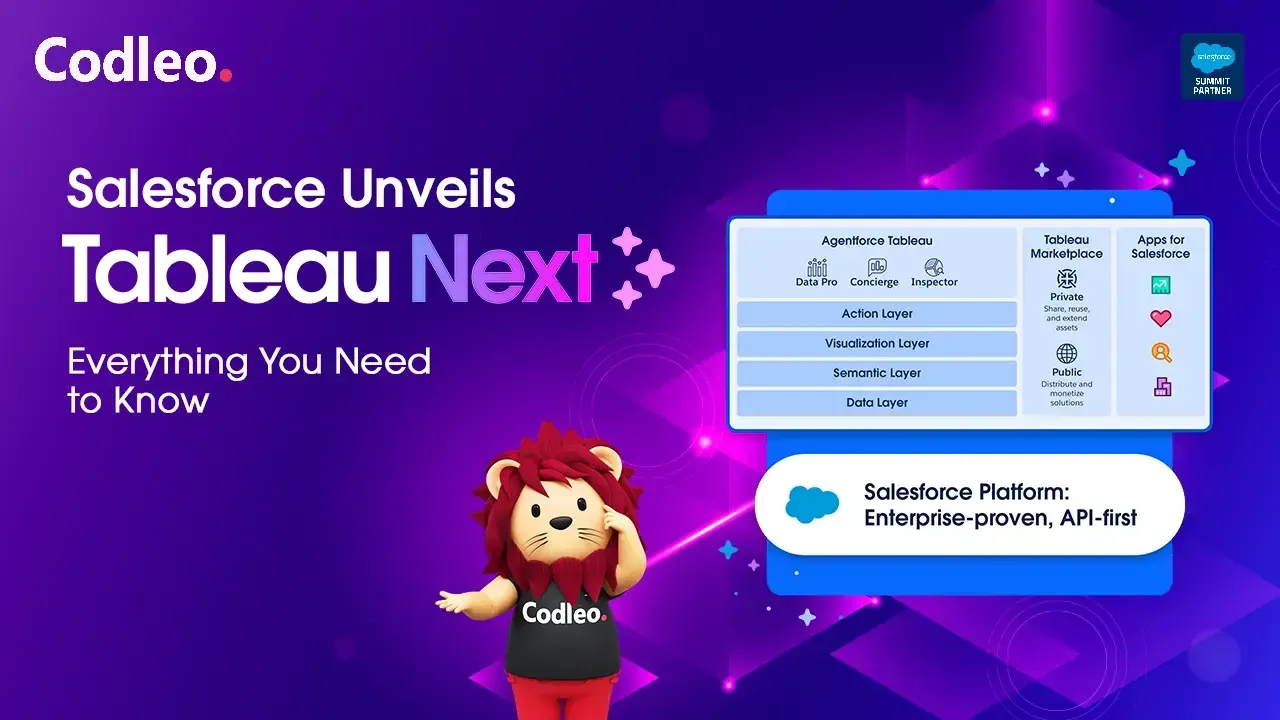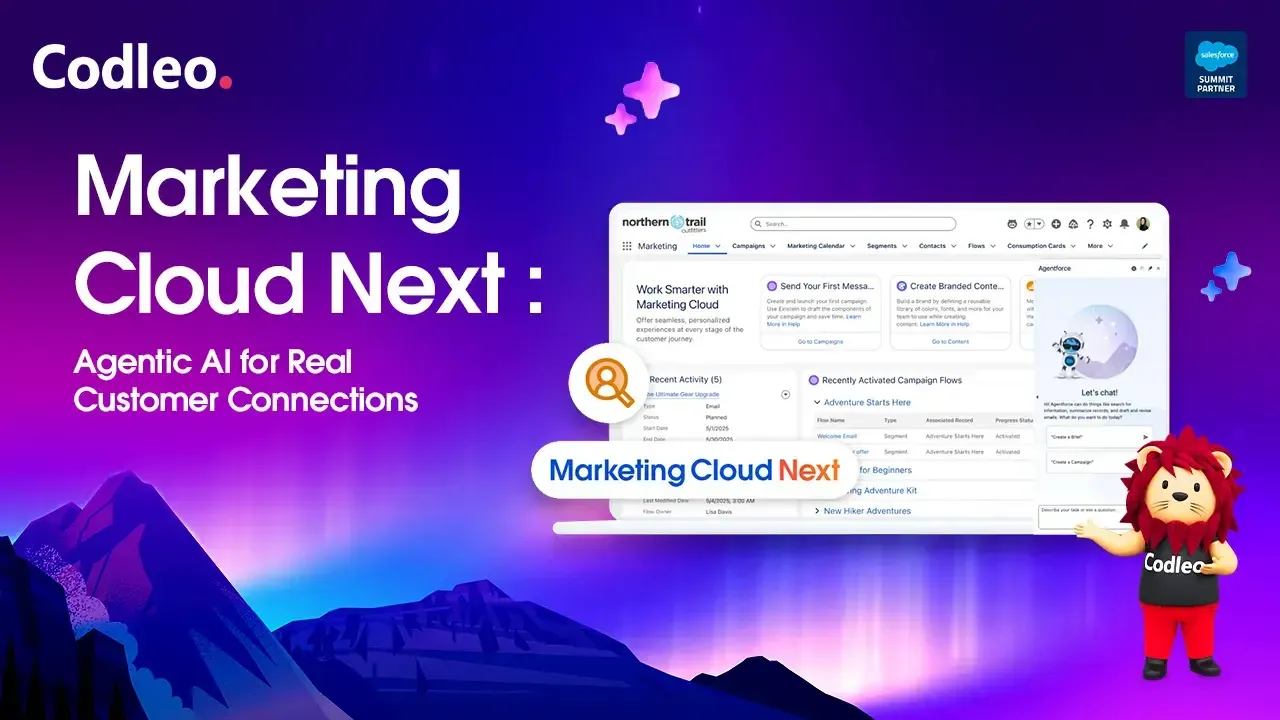Publish date:
Integrating telephony with Salesforce helps improve customer communication for sales, support, or service teams. With Salesforce Telephony, users can make and receive calls right within the Salesforce platform. This feature allows them to log interactions, access customer information, and manage workflows easily.
In this article, we will explore the Salesforce telephony options available, their key features and benefits, and provide a guide on getting started.
What Is Telephony in Salesforce?
In Salesforce, telephony refers to the direct connection of phone systems to the Salesforce platform. It enables sales and support teams to make, receive, and manage phone calls directly within Salesforce. It helps create smooth customer interactions and makes workflows easier.
Telephony in Salesforce usually uses Voice over Internet Protocol (VoIP) services. Options include Salesforce’s Service Cloud Voice or third-party solutions like RingCentral and Natterbox.
These integrations offer helpful features, such as click-to-call, automatic call logging, customer details pop-ups, and smart call routing, directly within Salesforce.
With telephony, users can quickly access critical customer information during calls. It allows them to provide personalized and efficient service. It also helps sales teams follow up with leads, track call histories, and keep accurate records, all within Salesforce.
-
Read Also: SALESFORCE TO SLACK INTEGRATION
Salesforce Telephony Use Cases
Salesforce Telephony is not just for customer service, as many people think. It can help various industries, businesses, and teams. Here are some important uses:
-
Sales Teams: Sales reps can make calls easily with click-to-dial, automatically log calls, and use call lists for quick follow-ups. The Sales Dialer features include helpful tools such as call coaching and voicemail drop, which are particularly beneficial for sales teams that make numerous outbound calls.
-
Customer Service: Service agents receive instant pop-ups on their screens that display customer information, enabling them to handle calls more efficiently. Service Cloud Voice utilizes IVR and intelligent call routing to direct customers to the appropriate agent.
-
Call Centers: Salesforce Telephony enables call centers to manage a large volume of calls efficiently. It offers features like call recording, IVR (Interactive Voice Response), and real-time transcription. Managers can use analytics to track performance, monitor customer satisfaction, and manage workflows.
-
Healthcare Providers: Salesforce Telephony helps healthcare services by centralizing patient communication and streamlining interactions. It allows secure access to patient interaction histories, follow-up calls, and coordination among different care teams.
Key Features
Salesforce Telephony offers many features to improve communication and efficiency, including:
-
Click-to-Dial: You can call anyone in Salesforce with just one click, so you don’t have to dial manually.
-
Automatic Call Logging: Salesforce automatically records call details, including the time, duration, and caller, saving you from having to enter this information manually.
-
Screen Pop-Ups: When a call comes in, you see customer details right away, helping you access critical information quickly.
-
Call Controls: You can mute, hold, transfer, or set up a conference call directly in Salesforce during a call.
-
IVR and Call Routing: Calls are directed to the correct agent, reducing wait times and improving customer satisfaction.
-
Voicemail Drop: You can leave pre-recorded voicemails when a call isn’t answered, which saves time and ensures consistency.
Benefits
The benefits of a telephony solution are likely clear from the key features mentioned above. If you need more reasons, let’s examine the numerous benefits you can expect.
-
Increased Productivity: Click-to-dial, automatic logging, and voicemail drop save time. It allows agents to focus on helping customers instead of performing administrative tasks.
-
Enhanced Customer Experience: Screen pop-ups display customer details, and smart call routing delivers more personalized service.
-
Improved Data Accuracy: Real-time transcription and automatic logging capture all interactions accurately and reliably. This information is available for later reference.
-
Enhanced Collaboration: Sharing customer data and call records enables sales, support, and service teams to work more effectively together.
-
Actionable Analytics: Data from calls and transcriptions is stored in Salesforce Analytics. It provides us with insights into how agents perform, trends in calls, and customer satisfaction.
-
Cost Savings: Adding telephony to Salesforce can save you money. You will not need to buy phones or separate phone lines for each user, depending on the solution you choose.
Salesforce Telephony Solutions and Tools
1. Salesforce Call Center
Salesforce Call Center utilizes Computer Telephony Integration (CTI) to connect call systems with Salesforce. This connection enables features such as screen pops, call transfers, and real-time call logging. The main components include:
-
Call Center: Salesforce has a feature that connects it with call systems created by developers or partners.
-
Open CTI: This is a JavaScript API that helps developers create telephony solutions in the cloud. Open CTI is compatible with any platform, enabling agents to use their preferred browsers and devices.
-
Softphone: A phone system that lets you manage calls within Salesforce.
To set up a Salesforce Call Center, you generally need to install a CTI package from the AppExchange. Then, work with a developer or partner to use the Open CTI API. This API enables you to tailor the system to meet your specific phone system requirements.

After setting up the call center, agents can use a softphone to make and receive calls. A softphone is a phone interface that appears on the screen and works well with Salesforce. In Lightning Experience, the softphone is displayed in the footer, while in Classic, it appears in the sidebar. You can customize each call center to fit your specific workflows, including custom layouts and call directories.
Salesforce Call Center is a flexible tool that helps teams work more effectively and enhance customer experiences. It can adjust to changing business needs.
Salesforce Call Center is valid for both sales and service teams.
2. Salesforce Sales Dialer
Salesforce Sales Dialer is a tool for sales teams that enables them to make and manage calls directly from Salesforce, eliminating the need for a separate phone system. With Dialer, sales representatives can click on phone numbers in Salesforce, such as those in contact or lead records, to make instant calls.
The call panel appears at the bottom of the screen, allowing users to view and access important customer details, take notes, and create follow-up tasks or events during the call. The Dialer also automatically logs call details, saving time and keeping activity timelines current. Sales Dialer includes:
-
Call Lists: Streamlined call lists for efficient follow-up.
-
Inbound Calling: Users will see a preview of related records to ensure they are prepared before answering a call.
-
Voicemail Drop: Ability to pre-record and drop voicemails, saving time on repetitive tasks.
-
Localized Caller ID: Calls appear as local numbers, increasing answer rates.
This tool enables sales representatives to access call histories and notes quickly. It is designed for individuals who make a large number of outbound calls.
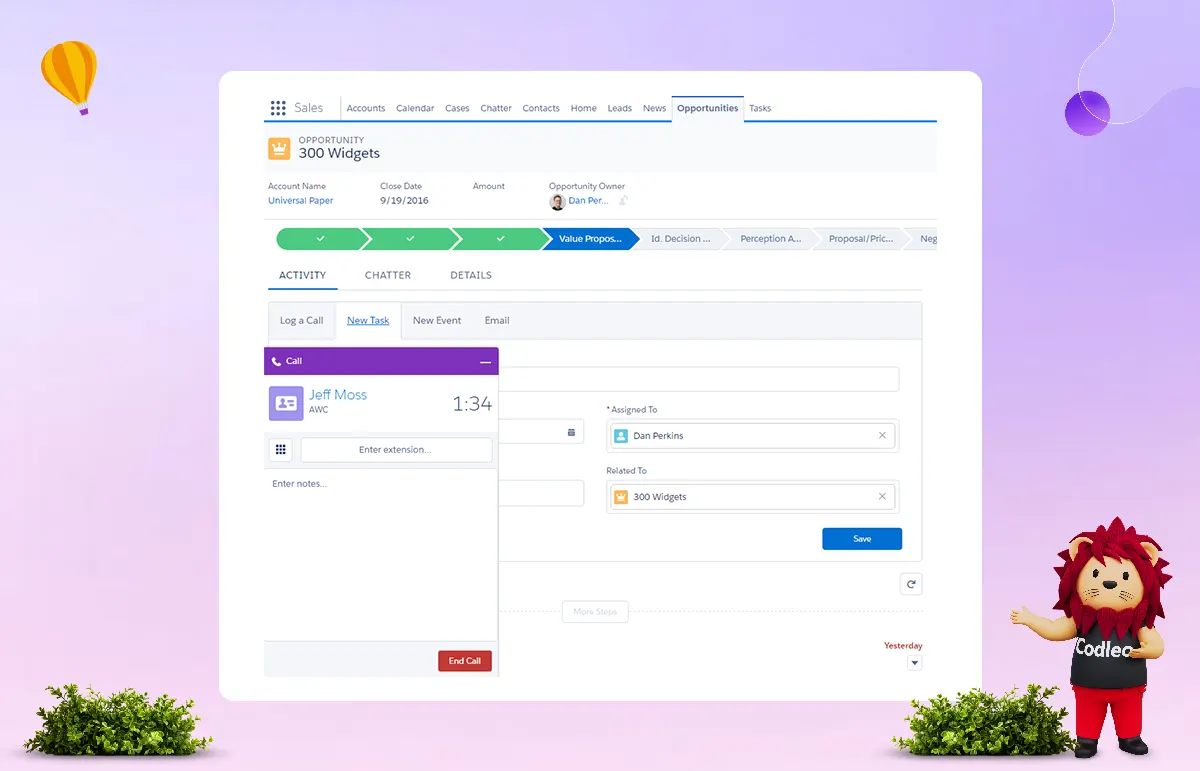
Sales Dialer has some limitations that may not work for everyone. It only allows calls within the U.S. and Canada. Additionally, certain features, such as call monitoring and voicemail capacity, have usage restrictions.
Sales Dialer vs. Call Center
A sales dialer and a Call Center may sound similar, but they serve distinct purposes.
-
Choose Salesforce Call Center (Open CTI) if you already use a phone system and want your sales and service teams to handle calls in Salesforce.
-
Choose Salesforce Sales Dialer if you focus on sales, do not have a phone system, or want to make calls directly in Salesforce without adding a new phone service.
3. Service Cloud Voice
Salesforce Service Cloud Voice is a tool that enhances phone support for customers and support agents. It connects phone calls directly to the Salesforce Service Console.
Agents can manage calls, as well as other digital interactions, such as chat, email, and social media. It provides them with a comprehensive view of each customer's history and current needs.
Agents can quickly respond to calls with features like real-time transcription and AI-driven recommendations from Einstein. These tools help agents identify the necessary steps during calls, enabling them to provide fast and effective service.
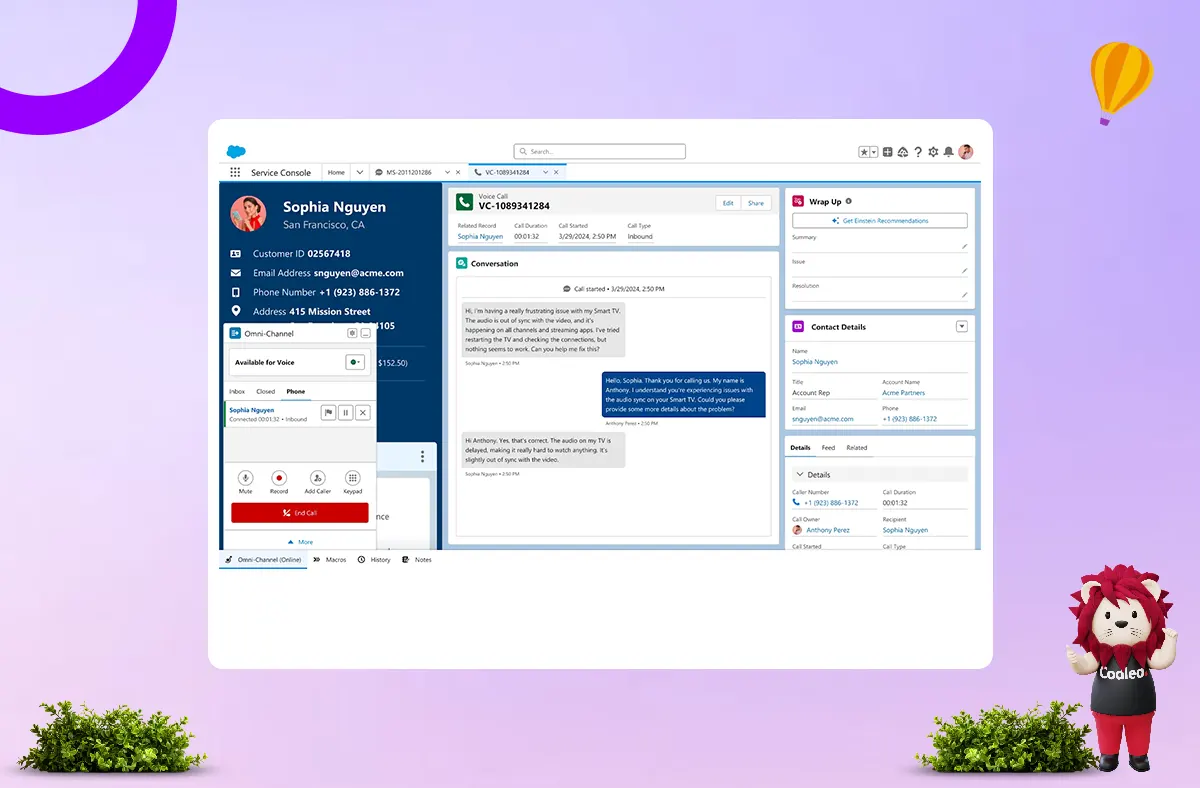
Service Cloud Voice enables supervisors to view calls easily and monitor agent performance in real-time. They can use Omni-Channel tools to monitor and manage calls across different digital channels.
This integration enables supervisors to easily reassign agents to handle call volume and provide assistance when needed. Service Cloud Voice integrates with multiple phone systems, allowing businesses to retain their existing phones while consolidating customer data and digital channels within Salesforce.
By combining phone service, AI, and customer information, companies can provide a personalized and efficient experience for customers in both service and sales.
Key features include:
-
Unified Communication Interface: Access customer data from all channels to get a complete view of each interaction.
-
Real-Time Transcription: Speech-to-text technology enables you to take accurate notes and record conversations.
-
Omni-Channel Integration: All customer interactions are consolidated in a single, easy-to-use interface. It helps agents efficiently manage calls along with other digital channels.
Service Cloud Voice is ideal for support teams that utilize multiple channels and require a comprehensive view of customers to resolve cases efficiently.
4. Einstein Conversation Insights (ECI)
Einstein Conversation Insights (ECI) is a Salesforce tool that helps sales teams capture and analyze data from customer calls. It aims to boost productivity and improve coaching. However, you will still need a separate telephony system to use with Einstein Conversation Insights (ECI).
ECI integrates seamlessly with popular meeting tools, including Zoom, Google Meet, and Microsoft Teams, as well as various phone dialers. It automatically creates call records in Salesforce. ECI provides complete transcripts of calls, AI-generated summaries, and real-time action suggestions. It helps sales representatives engage more with customers rather than focusing on taking notes.
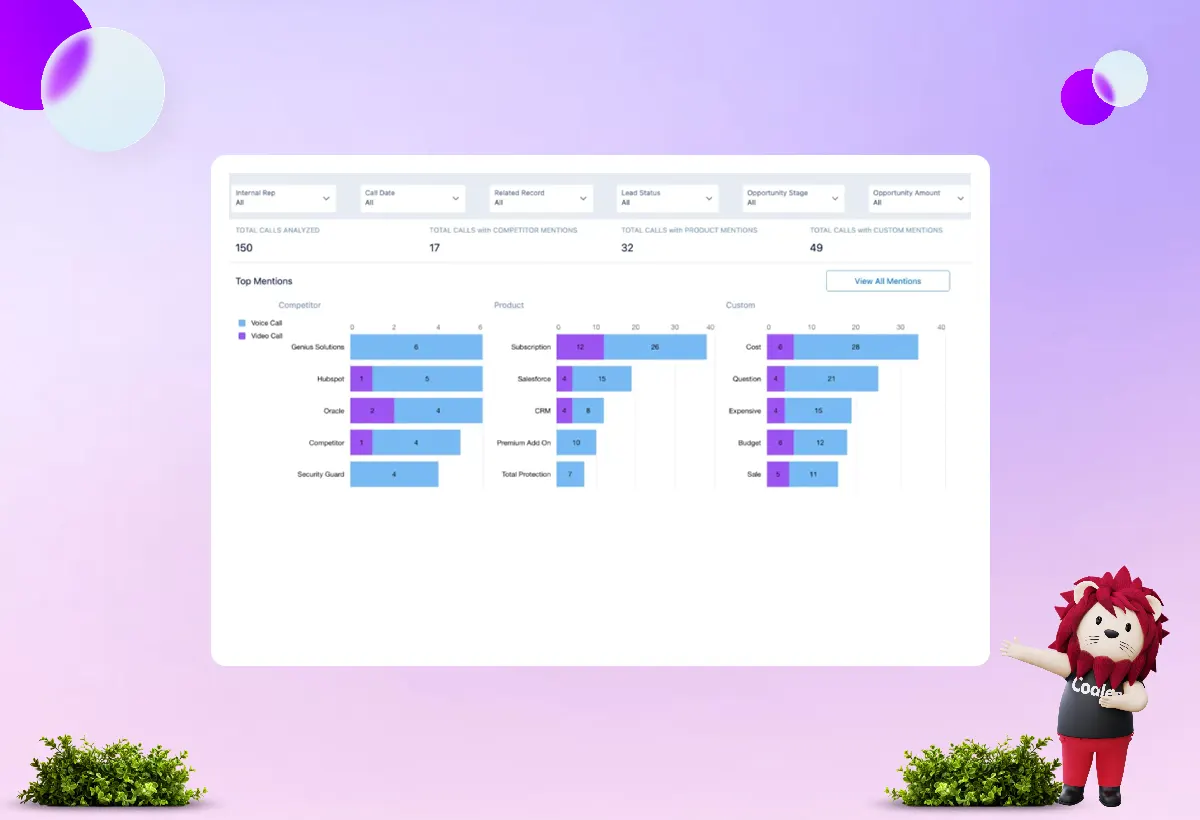
Einstein Conversation Insights (ECI) features include:
-
AI-Driven Transcripts and Summaries: This tool creates transcripts in 36 languages and provides summaries made by AI for quicker review.
-
Call Insights and Action Items: Identifies essential moments, like objections or discussions about pricing, and creates action items for the next steps.
-
Customizable Insights: Organizations can set keywords and phrases to track essential topics. It helps improve the relevance of the data.
-
Proactive Coaching: Managers can listen to calls, provide feedback, and organize calls into “Collections” for training or onboarding purposes.
-
Sales Signals: This tool utilizes AI to track the frequency of key phrases in sales conversations. It helps analyze those conversations more strategically.
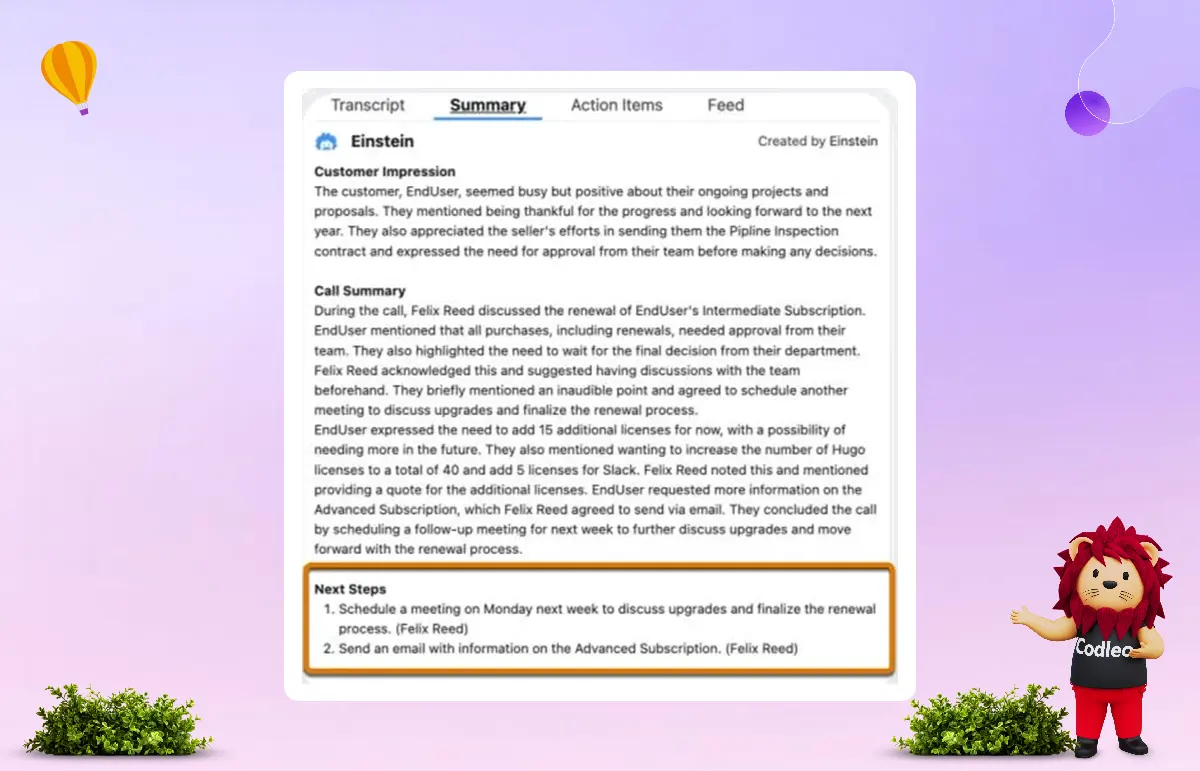
There are several considerations when deciding if Einstein Conversation Insights (ECI) is for you:
ECI works with various online meeting platforms, including Zoom, Google Meet, and Microsoft Teams, as well as some dialers such as Sales Dialer, RingCentral, and Aircall. Setting these up may require additional configuration or API integration for full functionality.
To access advanced features like Call Summaries, Call Explorer, and Sales Signals, you need the Einstein for Sales SKU or the Einstein 1 Sales Edition, along with Salesforce’s Data Cloud.
Choosing the Right Telephony Solution
Selecting the right telephony solution depends on your business needs and goals:
-
Sales Focus: Salesforce Sales Dialer helps sales teams in the US and Canada manage leads and track calls effectively.
-
Service-Oriented Teams: Service Cloud Voice is great for support teams that manage different channels and cases. It offers real-time transcription and analyzes customer sentiment.
-
Flexible Integration: Call Center and Open CTI enable businesses to connect with third-party phone services from the AppExchange easily. It gives them more control over how they set up their phone systems.
Resources
For more information about the Salesforce telephony options available to you, check out the following Trailhead modules and resources:
Top Features You Can Access with Salesforce Telephony Integration
CTI integration with Salesforce is popular among service teams due to its numerous valuable features. In this section, we will discuss some of these features and the benefits they provide.
1. Automated Dialing
Integrating CTI with Salesforce helps support teams communicate more effectively. It is achieved through features like predictive dialing, auto-dialers, and click-to-call. Predictive dialing enables teams to make multiple calls simultaneously and connects live calls to available agents. Click-to-call lets customers initiate calls by clicking links in apps or on websites.
2. Screen Pop Ups
CTI helps agents work more efficiently by displaying automated pop-up screens with important customer details when a call is received. Agents can quickly view key information, such as caller ID and call history. This comprehensive view means they don’t have to search for information manually, which enables them to provide better and faster customer service.
3. Call Transfer and Routing
CTI uses Automatic Call Distributor technology to manage calls based on data. When a call comes in, the system checks the customer’s information against the company’s database. It then sends the call to the best agent who has the right skills for that inquiry. For example, if a customer requests a refund, the Salesforce CTI system automatically identifies the appropriate agent and directs the call to them.
4. Streamlined Phone Controls
Salesforce CTI offers agents easy-to-use phone control features. These include call management, merging, and forwarding. By combining all these functions into one platform, agents can manage customer interactions smoothly without having to switch between their phone and computer systems.
-
Read Also: COMPLETE GUIDE TO SALESFORCE CTI INTEGRATION
How Salesforce Telephony Integration Boosts Team’s Potential
All the features of the Salesforce CTI integration help improve the team's performance. Here are a few points that highlight this.
1. Easier Call Handling for Effortless Engagement
Integrating CTI with Salesforce makes it easier for representatives to handle calls, allowing them to work more efficiently. With a built-in dialer in Salesforce and other customer service software, reps can start calls by clicking on a contact’s name or number. It saves time by avoiding the need to switch between different apps or use separate dialing tools. This seamless integration enhances productivity, enabling representatives to focus on building relationships with prospects and delivering exceptional service.
2. Improved Agent Experience
Salesforce CTI integration helps agents by allowing them to use one screen instead of switching between different programs. With Salesforce telephony integration, agents can see caller information and all necessary data in one place. It means they do not have to jump between various messaging apps to make calls or find information.
3. Simplified Performance Tracking for Managers
Managers can record both incoming and outgoing calls to monitor how agents interact with customers. They can use tools to analyze customer behavior and trends, which helps them create reports based on these insights.
4. Keep Data Up-To-Date
Integrating your telephone system with Salesforce allows you to log calls automatically. It creates a record of conversations, which can help resolve customer issues. To enhance your system, select a CTI or phone system that features call recording and transcription capabilities. These features provide solid proof in the event of any disputes.
The main advantage is real-time functionality. You can quickly respond to issues and address them before they escalate by accessing call logs and recordings immediately.
Hire Certified Experts for Salesforce Telephony Integration
Integrating Salesforce CTI can transform the way your agents interact with customers, resulting in improved customer engagement. It facilitates smoother communication, which enhances the overall customer experience.
Salesforce CTI efficiently handles customer inquiries, complaints, and requests. It ensures that customers leave satisfied, with all their questions answered. However, integrating Salesforce CTI can be complex, especially for organizations without internal development resources. To make this process easier, consider getting help from Salesforce experts.
Contact us to connect with top professionals in the field to optimize your Salesforce and telephony implementation.
-
Read Also: SALESFORCE MAILCHIMP INTEGRATION GUIDE
Summary
Salesforce Telephony offers numerous benefits by consolidating all your communication within Salesforce. It enables sales, service, and support teams to work more effectively and maintain customer satisfaction.
There are several solutions available, including Salesforce Call Center, Sales Dialer, and Service Cloud Voice, to meet different business needs. By using Salesforce Telephony, you can improve communication, making your business more responsive and efficient while meeting customer expectations.
Streamline your customer communication with Salesforce telephony integration. Codleo offers reliable Salesforce consulting services to help you connect your phone systems with Salesforce. With our proven expertise in Salesforce support and Salesforce integration, we ensure a seamless setup that improves team efficiency and customer satisfaction.
Contact us today to get started.








